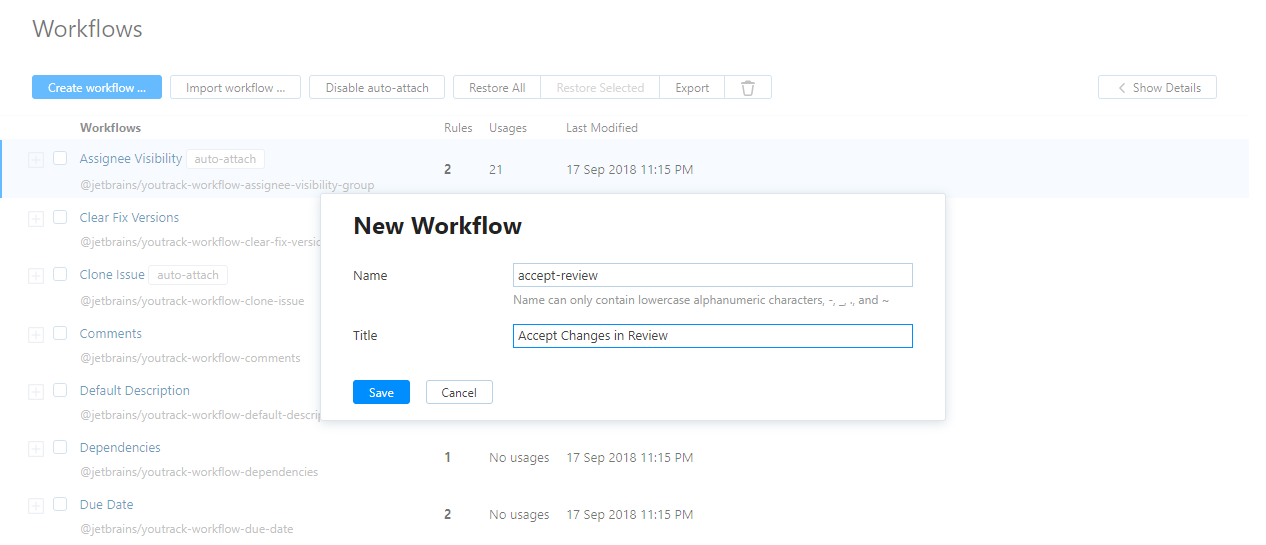

- #YOUTRACK WORKFLOW HOW TO#
- #YOUTRACK WORKFLOW INSTALL#
- #YOUTRACK WORKFLOW UPDATE#
- #YOUTRACK WORKFLOW DOWNLOAD#
Name the new rule and start writing the code. Then click the appropriate icon to create a rule, and start editing: Let's call the workflow ColoringOnDueDateApproach in our example. Run Workflow Editor and create a new workflow:
#YOUTRACK WORKFLOW UPDATE#
We will make two rules: one stateless, triggered when an issue is changed, to handle the creation of the new issues and changes of Due Date in existing ones, and the other scheduled, to update the color of the cards daily. We'll create the workflow first, then create rules in it. Let's call the project WebDev and the field DeadlineApproach, with the following values:ĭefine the colors when you add new values to the set of values available for the field.Īlso, the project should have a Due Date field where the deadline is specified. To have colored cards on the board, you need a field of enumeration type in your project. Our task now is to set up the project and create workflows to implement the board as described above. The color of the issue card represents the time left until the deadline: the card starts out green and then, based on a specific workflow, turns yellow and then red as the deadline approaches. Team members see which department is processing the issue at the moment. Board columns will stand for departments, and the team has a process of issue transition from one department to another. Suppose your team follows a Kanban process and would like to utilize YouTrack Agile Board. Make a new workflow for YouTrack Scenario
#YOUTRACK WORKFLOW DOWNLOAD#
If you’ve changed the set of fields or available fields' values in your project, download the workflows again, as shown below.

To do so, select Settings | Database Backup in YouTrack as shown below:Īlong with workflows, Workflow Editor also downloads a scheme of your projects. Therefore, we strongly recommend backing up your YouTrack database before updating workflows. Note: Mistakes in custom workflow rules may lead to the inadvertent removal of important data or YouTrack database corruption.

Likewise, upload your workflows to YouTrack as soon as you finish working on them. To have the most recent workflows, always download them from the server before creating/modifying them. Upon start, synchronize workflows in Workflow Editor and YouTrack server. Then you can assign a role with these permissions to a user, by selecting Settings | Users in YouTrack as shown below: Download workflows from your YouTrack server You can always customize roles by assigning ‘Low-level Administration’ permissions to other roles, by selecting Settings | Roles in YouTrack. Only the Admin role has such permissions by default. Low-level administrator permissions are required to create and edit workflows. When you run YouTrack Workflow Editor for the first time, configure it by providing YouTrack server URL, as well as the username and password for a user who has low-level administration permissions in YouTrack. Note: If you run Workflow Editor on Linux, please ensure you run it with Java 6, as higher JRE versions are not supported on Linux. Workflow Editor is a separate Java application required to create or modify workflows.
#YOUTRACK WORKFLOW INSTALL#
Set up and configure Workflow Editor Download and install Workflow Editorĭownload and install Workflow Editor from Get YouTrack website page. Section 3 wraps the process up with the necessary steps for new workflow activation in your YouTrack instance. Your requirements could be different from what we took as an example, but you can follow the same pattern. Section 2 shows the process of making a new workflow and rules for a particular use case.
#YOUTRACK WORKFLOW HOW TO#
Section 1 describes how to set up Workflow Editor and assign the appropriate permissions in YouTrack.

Whether you wish to create a workflow from scratch or modify an existing one, you need Workflow Editor, the application for working with workflows. Read this tutorial if you want to make workflows and rules for YouTrack. This tutorial describes how to create new rules or modify existing ones, how to make a particular workflow, and how to use the workflow language. There are three types of rules: stateless, state-machine, and scheduled. With workflows you can easily notify teams about events, enforce policies, execute periodic tasks, and maintain a smooth flow of existing business processes. Workflows in YouTrack are a way to automate tasks.


 0 kommentar(er)
0 kommentar(er)
